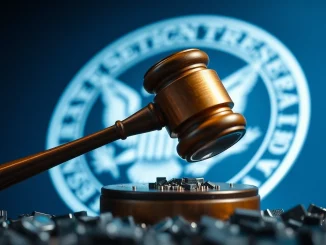
Exciting news for the crypto world! The U.S. Treasury is taking a proactive step to foster innovation in the digital asset space. Secretary Scott Bessent has announced a comprehensive review of existing regulatory barriers that might be hindering the growth and adoption of blockchain technology, stablecoins, and cutting-edge payment systems. This move signals a potential shift towards a more accommodating regulatory landscape, sparking hope and anticipation within the fintech industry. Let’s dive into what this could mean for the future of crypto and finance.
Why is the US Treasury Examining Regulatory Barriers?
The US Treasury, under the leadership of Secretary Scott Bessent, is recognizing the transformative potential of blockchain and digital assets. This review isn’t just about keeping up with technological advancements; it’s about ensuring the United States remains a leader in financial innovation. Here’s why this examination is crucial:
- Fostering Innovation: Excessive or outdated regulations can stifle innovation. By identifying and removing unnecessary barriers, the Treasury aims to create a more fertile ground for fintech companies and developers to build and deploy new blockchain-based solutions.
- Economic Competitiveness: Other nations are actively exploring and adopting blockchain and digital assets. The U.S. needs to ensure its regulatory environment doesn’t put it at a disadvantage in the global race for technological and economic leadership.
- Consumer Protection and Financial Stability: While promoting innovation is key, the Treasury also needs to balance this with protecting consumers and maintaining financial stability. The review will likely aim to find a sweet spot – regulations that are effective yet not overly burdensome.
- Modernizing Payment Systems: Traditional payment systems can be slow, expensive, and inefficient. Blockchain and stablecoins offer the promise of faster, cheaper, and more accessible payment solutions. Regulatory clarity is essential to unlock this potential.
What are the Current Regulatory Barriers to Blockchain and Stablecoins?
The cryptocurrency and blockchain space has long grappled with regulatory uncertainty. While some regulations are necessary to protect investors and prevent illicit activities, others may be unintentionally hindering progress. Some key regulatory barriers being discussed include:
| Barrier | Impact on Blockchain & Stablecoins |
|---|---|
| Lack of Clarity in Securities Laws: | Determining whether a digital asset is a security or not is often complex. This ambiguity creates uncertainty for projects launching tokens or stablecoins, impacting fundraising and operations. |
| Money Transmitter Regulations: | Many crypto businesses are classified as money transmitters, subjecting them to state-by-state licensing requirements, which can be costly and time-consuming, especially for smaller startups. |
| Bank Secrecy Act (BSA) and Anti-Money Laundering (AML) Compliance: | While crucial, AML and KYC (Know Your Customer) compliance can be challenging and expensive for blockchain-based services, potentially limiting accessibility and innovation. |
| Taxation Complexity: | The tax treatment of cryptocurrencies is still evolving and can be complex, deterring wider adoption and investment. |
| Interoperability of Regulations: | Inconsistencies between federal and state regulations, and even international regulations, create a fragmented and challenging landscape for businesses operating across jurisdictions. |
The Transformative Potential of Blockchain Technology
Blockchain technology, the underlying innovation behind cryptocurrencies, extends far beyond digital currencies. Its decentralized, transparent, and secure nature offers a wide range of benefits across various sectors. Easing regulatory barriers could unleash its full potential in areas like:
- Supply Chain Management: Improving transparency and traceability in supply chains, reducing fraud and inefficiencies.
- Healthcare: Securing patient data, streamlining medical records management, and enhancing pharmaceutical supply chain integrity.
- Voting Systems: Creating more secure and transparent voting processes, potentially increasing voter participation and trust.
- Digital Identity: Providing individuals with greater control over their digital identities and data.
- Intellectual Property Protection: Securing and managing intellectual property rights more effectively.
Stablecoins: Bridging the Gap Between Traditional Finance and Crypto
Stablecoins are cryptocurrencies designed to maintain a stable value, typically pegged to a fiat currency like the US dollar. They aim to combine the benefits of cryptocurrencies – speed, efficiency, and accessibility – with the price stability of traditional currencies. Reducing regulatory barriers could accelerate the adoption and use cases of stablecoins, including:
- Faster and Cheaper Payments: Facilitating cross-border payments and remittances with lower fees and faster settlement times compared to traditional methods.
- Decentralized Finance (DeFi): Serving as a crucial building block for DeFi ecosystems, enabling lending, borrowing, and trading activities with greater efficiency.
- Reduced Volatility in Crypto Trading: Providing traders with a less volatile asset to park funds during periods of market uncertainty.
- Increased Financial Inclusion: Offering access to financial services for the unbanked and underbanked populations globally.
- E-commerce and Retail Payments: Potentially becoming a mainstream payment option for online and offline transactions.
Revolutionizing New Payment Systems with Blockchain
The Treasury’s review also encompasses “new payment systems,” indicating a broader vision beyond just blockchain and stablecoins. This suggests an interest in fostering innovation across the entire spectrum of financial technology. By removing regulatory barriers, the US can pave the way for:
- Central Bank Digital Currencies (CBDCs): While not explicitly mentioned, regulatory clarity around blockchain could indirectly support the development and potential implementation of a US CBDC.
- Real-Time Payment Systems: Encouraging the development of faster and more efficient real-time payment infrastructures.
- Programmable Money: Exploring the potential of programmable money and smart contracts to automate financial transactions and processes.
- Open Banking Initiatives: Facilitating the secure sharing of financial data to enable innovative financial services and applications.
Conclusion: A Promising Step Towards a More Innovative Future
The U.S. Treasury’s move to review regulatory barriers for blockchain, stablecoins, and new payment systems is a significant and hopeful development for the cryptocurrency and fintech industries. By proactively addressing these challenges, the government is signaling a willingness to embrace innovation while ensuring responsible growth and consumer protection. This initiative has the potential to unlock tremendous opportunities, propelling the U.S. to the forefront of the global digital economy and ushering in a new era of financial innovation. The world will be watching closely to see how these regulatory adjustments unfold and the exciting developments they will catalyze.



